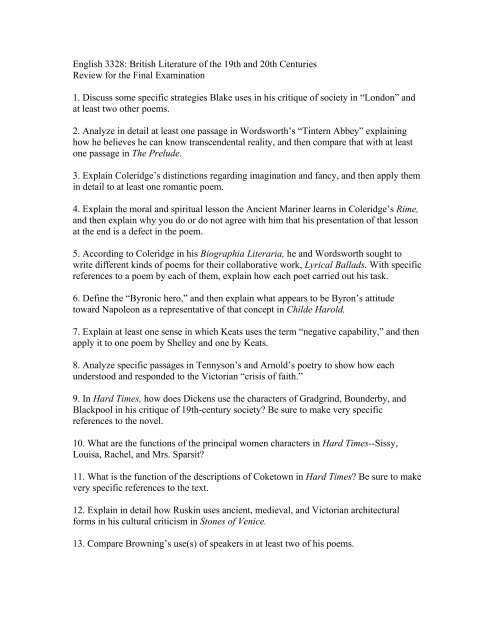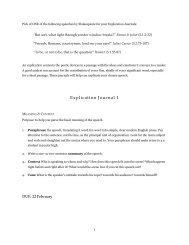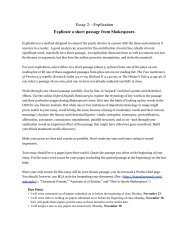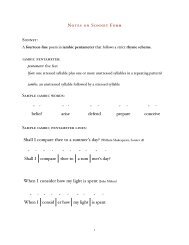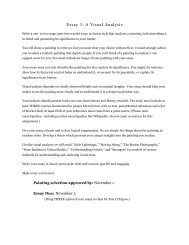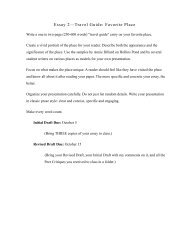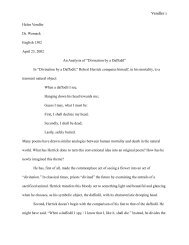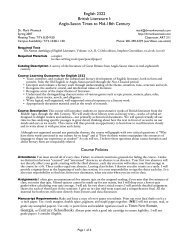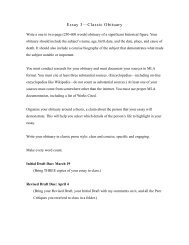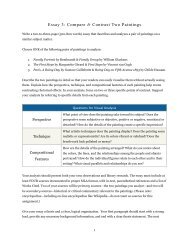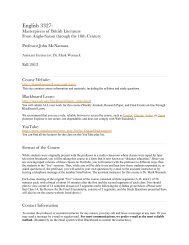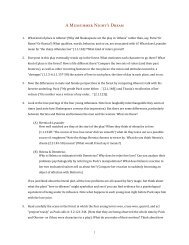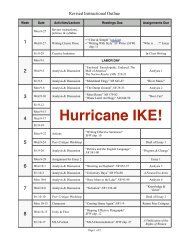English 3328: British Literature of the 19th and ... - Dr. Mark Womack
English 3328: British Literature of the 19th and ... - Dr. Mark Womack
English 3328: British Literature of the 19th and ... - Dr. Mark Womack
You also want an ePaper? Increase the reach of your titles
YUMPU automatically turns print PDFs into web optimized ePapers that Google loves.
<strong>English</strong> <strong>3328</strong>: <strong>British</strong> <strong>Literature</strong> <strong>of</strong> <strong>the</strong> <strong>19th</strong> <strong>and</strong> 20th CenturiesReview for <strong>the</strong> Final Examination1. Discuss some specific strategies Blake uses in his critique <strong>of</strong> society in “London” <strong>and</strong>at least two o<strong>the</strong>r poems.2. Analyze in detail at least one passage in Wordsworth’s “Tintern Abbey” explaininghow he believes he can know transcendental reality, <strong>and</strong> <strong>the</strong>n compare that with at leastone passage in The Prelude.3. Explain Coleridge’s distinctions regarding imagination <strong>and</strong> fancy, <strong>and</strong> <strong>the</strong>n apply <strong>the</strong>min detail to at least one romantic poem.4. Explain <strong>the</strong> moral <strong>and</strong> spiritual lesson <strong>the</strong> Ancient Mariner learns in Coleridge’s Rime,<strong>and</strong> <strong>the</strong>n explain why you do or do not agree with him that his presentation <strong>of</strong> that lessonat <strong>the</strong> end is a defect in <strong>the</strong> poem.5. According to Coleridge in his Biographia Literaria, he <strong>and</strong> Wordsworth sought towrite different kinds <strong>of</strong> poems for <strong>the</strong>ir collaborative work, Lyrical Ballads. With specificreferences to a poem by each <strong>of</strong> <strong>the</strong>m, explain how each poet carried out his task.6. Define <strong>the</strong> “Byronic hero,” <strong>and</strong> <strong>the</strong>n explain what appears to be Byron’s attitudetoward Napoleon as a representative <strong>of</strong> that concept in Childe Harold.7. Explain at least one sense in which Keats uses <strong>the</strong> term “negative capability,” <strong>and</strong> <strong>the</strong>napply it to one poem by Shelley <strong>and</strong> one by Keats.8. Analyze specific passages in Tennyson’s <strong>and</strong> Arnold’s poetry to show how eachunderstood <strong>and</strong> responded to <strong>the</strong> Victorian “crisis <strong>of</strong> faith.”9. In Hard Times, how does Dickens use <strong>the</strong> characters <strong>of</strong> Gradgrind, Bounderby, <strong>and</strong>Blackpool in his critique <strong>of</strong> <strong>19th</strong>-century society? Be sure to make very specificreferences to <strong>the</strong> novel.10. What are <strong>the</strong> functions <strong>of</strong> <strong>the</strong> principal women characters in Hard Times--Sissy,Louisa, Rachel, <strong>and</strong> Mrs. Sparsit?11. What is <strong>the</strong> function <strong>of</strong> <strong>the</strong> descriptions <strong>of</strong> Coketown in Hard Times? Be sure to makevery specific references to <strong>the</strong> text.12. Explain in detail how Ruskin uses ancient, medieval, <strong>and</strong> Victorian architecturalforms in his cultural criticism in Stones <strong>of</strong> Venice.13. Compare Browning’s use(s) <strong>of</strong> speakers in at least two <strong>of</strong> his poems.
14. Compare some <strong>of</strong> <strong>the</strong> attitudes <strong>of</strong> <strong>the</strong> Aes<strong>the</strong>tes <strong>of</strong> <strong>the</strong> 1890’s with those <strong>of</strong> at leasttwo World War I poets, making specific reference to at least one work by each writer youdiscuss.15. Explain in detail how Pater <strong>and</strong> Hopkins anticipate many <strong>of</strong> <strong>the</strong> features <strong>of</strong>modernism.16. In Conrad’s Heart <strong>of</strong> Darkness, how does Kurtz figure in <strong>the</strong> critique <strong>of</strong> Westerncivilization? Be sure to make very specific references to <strong>the</strong> text.17. Compare Darwin’s <strong>and</strong> Conrad’s (or Marlow’s) ambivalence toward recognizing<strong>the</strong>ir kinship with non-Western peoples. Be sure to make specific references to works byeach author.18. What is <strong>the</strong> function <strong>of</strong> Conrad’s descriptions <strong>of</strong> Europe <strong>and</strong> Africa in Heart <strong>of</strong>Darkness? Be sure to make very specific references to <strong>the</strong> text.19. Compare at least one poem by Yeats <strong>and</strong> at least one by Eliot as modernistexperiments.20. Compare <strong>the</strong> views <strong>of</strong> educational <strong>and</strong> career opportunities for women in one work byEllis <strong>and</strong> one by Woolf. Be sure to make very specific references to <strong>the</strong>ir works.21. In what specific ways does Woolf in Mrs. Dalloway carry out her critique <strong>of</strong> <strong>the</strong>pressures toward conformity in modern society?22. Explain what is meant by “stream <strong>of</strong> consciousness” as a narrative device, <strong>and</strong> <strong>the</strong>nanalyze how Woolf employs it in at least one extended passage <strong>of</strong> Mrs. Dalloway.23. What is <strong>the</strong> function <strong>of</strong> <strong>the</strong> descriptions <strong>of</strong> London in Mrs. Dalloway? Be sure tomake very specific references to <strong>the</strong> text.24. Discuss in detail how Larkin, Hughes, <strong>and</strong> Heaney respond to a continuing sense <strong>of</strong> a“crisis <strong>of</strong> faith.”25. How does Heaney view his role as poet in relation to <strong>the</strong> traditional society fromwhich he comes? Be sure to make very specific references to his poems.


